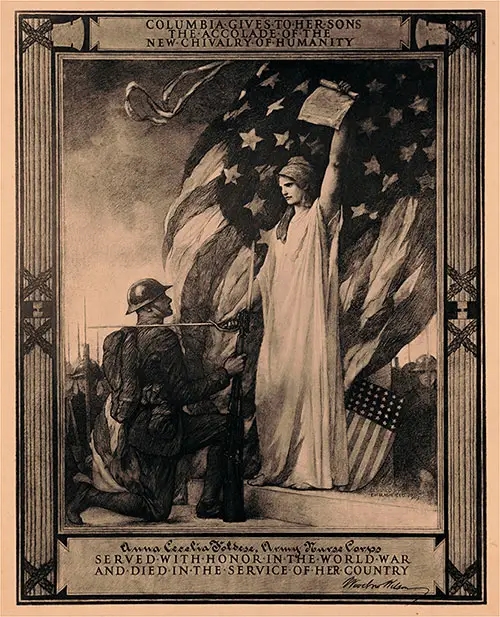Discovery of the Influenza Germ - 1919

Columbia Gives to Her Sons the Accolade of the New Chivalry of Humanity Anna Cecilia Foldesi, Army Nurse Corps Served the Honor in the World War and Died in the Service of Her Country. Certificate shows Columbia holding a proclamation above her head in one hand while touching a sword to the shoulder of a World War I doughboy who kneels at her feet with the other hand. A large sized US flag flies behind her along with the faces of other soldiers. Certificate was intended for, and inscribed with her name, Anna Cecilia Foldesi (1890-1918) who served as a Red Cross nurse in World War I. Though Blashfield's design shows Columbia "knighting" a kneeling doughboy, this certificate honors the service of Red Cross nurse Anna Cecilia Foldesi. Shortly after arriving at Iowa's Camp Dodge, Foldesi (name misspelled as Foldese on the certificate) died of influenza and pneumonia on November 8th, days before the war ended. Millions more died from the wartime influenza pandemic of 1918-1919 than from enemy weapons. Library of Congress Prints and Photographs Division. LC # 2013650540. GGA Image ID # 150251facb
An account of the discovery by Major H. Graeme Gibson, Major Bowman, and Captain Connors of the Allied army medical services, of what is stated to be very probably the causative germ of influenza appeared lately in the London Times.
The germ belongs to the order of filter-passers and is grown by the Noguchi method. The discovery cost Major Gibson his life, as he fell a victim to the very virulent strains of the germ with which he was experimenting.
- Scientific American, Vol. CXX, No. 20, 17 May 1919, p. 513
Organisms of Yellow Fever and Influenza
SCIENCE, in its issue of April 18, 1919, has taken from the London Times a note concerning the death of Major H. Graeme Gibson, R. A. M. C. Dr. Gibson, with his co-workers, Major Bowman, C.A.M.C., and Captain Conner, A.A.M.C., had just completed the discovery of what is very probably the causative organism of the influenza.
On December 14, 1918, the British Medical Journal published a preliminary note from these three doctors concerning the influenza germ, but at that time the discovery lacked complete evidence.
Major Gibson's death, however, completes the evidence. He was a victim of the germ \which he had tried so earnestly to identify, and pneumonia quickly followed this attack. .
The germ belongs to the order of filter passers. It is grown by the Noguchi method. Monkeys have been infected with it and have manifested hemorrhages in the lungs.
The work of Captain Wilson, mentioned in a recent number of the British Medical Journal, also confirms that of Major Gibson. The fact that this important investigation has been carried on by the Army Medical Corps is a complimentary reflection on that service.
Following closely upon the success of Major Gibson's work comes the description by Professor Noguchi of a new germ in connection with yellow fever. He states that the organism which he has discovered belongs to the spirochete class.
In the 17th century the disease was first discovered; and although it ravaged many European cities, it remained a mystery until 1881, when Dr. Charles Finlay of Havana declared that the infection was carried by the mosquito.
Then, in the Spanish American War, came Reed's commission of investigation and at that time Dr. Finlay's theory was substantiated, but with the sacrifice of many valuable lives.
"It has proved that the mosquito stegomyia fasciata is the agent of infection, that the virus of the disease is present in the blood during the first days of infection, and that 'the germ is so small that it can pass through a Chamberland filter."
Infection could not be produced till after several days from the time when the mosquito had bitten the yellow fever patient. so that it was evident that the germ underwent some change in the body of gas to make possible the completion of the Panama Canal by ridding the zone, which up to this time had been a hotbed, of yellow fever.
Professor Noguchi's declaration is an extremely interesting one, especially in view of the fact that it has been suggested that the spirochetes pas through two stages of development, one of which is extremely minute. However, whether or not this view will be confirmed, through the new discovery, has not been proved.
"The Organisms of Yellow Fever and Influenza," in the Boston Medical and Surgical Journal: Official Organ of the Massachusetts Medical Society and of the New England Surgical Society, Boston: The Boston Medical and Surgical Journal Society, Inc., Vol. CLXXX, No. 211, Thursday, 22 May 1919, p. 591.
